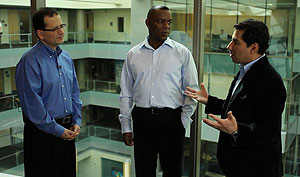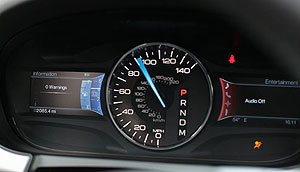SAN FRANCISCO — April 20, 2011 — To a meteorologist, a cloud consists of billions of droplets suspended as vapor that can stretch for miles and subtly affect everything on the ground below. In an enterprise IT environment, billions of devices can gather data from interactions all over the world, and produce a profound effect on the way organizations plan, act and work.
Earlier today at the SMART Technology World conference in San Francisco, Microsoft Windows Embedded General Manager Kevin Dallas illustrated what clouds and cloud computing have in common, and explained why the Internet of Things is going to change the way enterprises capitalize on data.
The Embedded Device Explosion
Today powerful processors can be embedded into almost any kind of device. Operating systems for such devices have become small and powerful enough to facilitate a wide range of functions and interactions. And almost anything can be connected to the Internet.

Dr. Abel Sanchez, MIT (right), speaks with Kevin Dallas, general manager, Windows Embedded (center), and Yousef Khalidi, distinguished engineer, Windows Azure.
The combination of these factors has led to rising demand for computing power that extends well beyond the desktop and the server room out into the realm of everyday things, and this pressure is rapidly transforming the way embedded devices are built, the way they are used, and the value they provide across business and personal life.
According to research firm International Data Corp. (IDC), the number of “smart systems” — devices with powerful processors, operating systems and connectivity — will more than double between 2010 and 2015, and double again within five years after that. Shipments of embedded systems with the ability to connect to the Internet will grow from approximately 1.4 billion in 2010 to over 3.3 billion in 2015.
Microsoft Distinguished Engineer Yousef Khalidi, whose work has been foundational in Microsoft’s Windows Azure cloud operating system, says this proliferation of processing power embedded into a range of devices poses both a huge challenge and an interesting proposition.
“Today we have devices in cars, point-of-sale systems, production line environments and so forth, and this device universe will only increase,” Khalidi says. “It will go down to a small light bulb in every room having an IP address, sending data about its state. So the question really is, what do you do with all the data? How do you compute over it, run your analytics over it and make sense of it?”
The Internet of Things
In explaining this concept onstage, Dallas showed a short film featuring Dr. Abel Sanchez of MIT’s Geospacial Data Center, who introduced a new term into the technology lexicon. MIT’s theory of the Internet of Things describes an interconnected Web of devices that both collect and precipitate information.
“The Internet of Things is a theory we developed at MIT to describe a state where the physical objects around us are interconnected by a network,” Sanchez says. “Now billions of things can be tracked, or can gather and process data, or can provide a service — and then through the cloud, all these things seamlessly interact.”
According to Sanchez, the “things” involved can range from simple sensors that monitor humidity or motion all the way to intelligent devices with enough computing power to process large volumes of data.
The potential result of this is something that Dallas calls “extended intelligence,” where devices continually feed information back to PCs and servers, providing rich, detailed data that allows for more insight and intelligence.
According to Khalidi, all that data requires a vast amount of storage, as well as the processing power to make sense of it all, and that’s why the cloud is the essential element that makes the Internet of Things a reality. The connectivity of these devices through Wi-Fi or cellular networks brings the cloud into play, offering near limitless computing power to process and analyze the information delivered by the devices.
“To unlock the power of this data, powerful programs and services have to be able to aggregate it all, correlate the events and make use of the data,” Khalidi says. “And this computation has to run somewhere. And has to run on a very large scale. And for this, a cloud platform is ideal.”
Khalidi says that Windows Azure, a very large storage system, is already able to consume and store all this data today. With Windows as a platform that extends from the device level, to the desktop, all the way to the cloud, developers can now capitalize on a tremendous opportunity to use their existing knowledge of Microsoft tools — and create the applications that will power this next generation of intelligent systems.
“What excites me the most, frankly, are all the applications that have not yet been written to really unlock the power of the data,” Khalidi says. “The future is really very exciting. We like scale, and we have built a very scalable system in Windows Azure for that.”
The Power of Smart Devices

The cloud allows almost any kind of device to be transformed into an intelligent system that generates powerful information for companies.
In describing the potential of intelligent systems, Dallas gives a simple example — gas pumps — explaining how advanced embedded platforms integrated into an appliance that has been around for more than a century can extend business intelligence all the way out to the customer’s fingertips.
“Most people don’t think much about gas pumps, but when the data from sensors embedded in the pumps is aggregated, analyzed and compared with data from other nearby gas stations, all of a sudden some incredible business analytics can emerge,” Dallas says. “The enterprise that owns these gas stations can examine what types of fuel are selling better, what times of day are most popular, and how pricing fluctuations affect sales.”
That kind of detailed information can lead to better decisions on the part of the fuel company — more targeted delivery routes, for example, or highlighting high-volume regions that may benefit from a new gas station.
Going deeper into the analytics and business intelligence, the company can identify new device functions and additional sales opportunities. Collecting the data through automated devices also creates inherent operational efficiency.
“Because the devices are connected in real time, all this is done without the need to send someone to monitor each device, thus enabling the company to use its manpower somewhere else,” Dallas says.
Embedded systems today have reached a point of such maturity and flexibility, Dallas says, that almost any kind of device can be transformed into an intelligent system that creates powerful information for companies. In fact, he says it’s already happening in industries all over the world.
Stratospheric Possibilities
According to Dallas, the Windows Embedded platform is capable today of powering almost any scenario that involves the exchange of information between embedded devices, PCs and servers.
“When you add a Windows-based operating system to the device and the cloud, customers can absorb and then project almost any kind of data, easily and constantly,” he says. “When we look at the sheer volume of potential for this kind of information exchange, that’s what gets us so excited about what we’re doing.”
Dallas says Windows Embedded offers the advantage of having Microsoft’s full arsenal — technologies, resources, industry experience and partner ecosystem — to develop extended intelligence within an existing enterprise infrastructure, giving customers the ability to design an embedded solution that can fit any business need.
“As you begin to plan how to use Windows Embedded and the cloud, we can match solutions to your needs, combine your technology with our tools, and help develop a next-generation IT infrastructure,” he says.
Dallas notes other applications that have already been developed, including personalized digital signs for retail that respond to individual customers, connected health records that can help medical teams deliver more holistic care, real-time factory data that can keep inventories and raw materials moving in synchronicity, or consumer-facing intelligent devices such as embedded automotive infotainment systems featuring voice recognition to control entertainment and climate systems.
Which brings up an observation from meteorologist Shannon O’Donnell, an authority on climate systems, who also appeared in Dallas’ video at SMART Technology today: “What I see Microsoft doing is recreating the power of the clouds, but with the added benefit of being able to control what goes into them, when it comes out, and where it goes. In this case, the question is no longer ‘What is this cloud going to do?’ but rather ‘What am I going to do with the cloud?’”
For more information on Windows Embedded and building smart systems to power any organization, visit Microsoft’s Windows Embedded home page.




